
Navigate to the Azure portal and log on with an account that has appropriate permissions.Smart lockout is included in all Azure AD tenants but custom settings will require Azure AD P1 or P2. Smart lockout can recognize sign-ins coming from valid users and therefore can lock out the attacker while letting your users continue to access their accounts. Smart lockout can block attackers who are trying to guess you users’ passwords.
#OFFICE 365 PASSWORD RESET ADMIN PASSWORD#
Select Password expiration policy and deselect Set user passwords to expire after a number of days.Click on Settings followed by Security & Privacy.Navigate to the Microsoft 365 Admin Center and log on with a global administrator.

Note that you should definitely configure multi-factor authentication before doing this! Microsoft recommends disabling password expiration.
#OFFICE 365 PASSWORD RESET ADMIN HOW TO#
How to improve? Disable password expiration All remaining characters are given 1 point each.A score of at least 5 is required for the password to be accepted. Substring matching will look for the first name, last name en tenant name in the password.Īfter applying all steps above a password score will be calculated. Substring matching is applied on the normalized passwords.If ‘AzureScene’ is on the password list and a users changes his password to ‘BzureScene’ the password is denied because it is within an edit distance of 1 of AzureScene. Fuzzy matching is applied on the normalized passwords, based on an edit distance of one comparison.They’ll replace all uppercase letters with smallercase and common character substitutions are performed (an ‘O’ becomes an ‘0’, an ‘I’ becomes a ‘1’, …) Normalization is used to map a small set of passwords to a much larger set.You can some neat documentation on this but i’ll add a brief overview for completeness. To assess the strength of a new password, Microsoft will go through a few steps and will accepted or reject based on the outcome.

Microsoft uses the lists above to determine if a passwords is considered safe. This way you can block passwords that are primarily focused on organizational-specific terms like brand names and product names.

It’s possible to add a custom banned password list on top of the global list. It’s important to note that Microsoft doesn’t use third-party/public password lists – all data is coming from Azure AD itself. They look for commonly used passwords that are weak and/or compromised. Microsoft has a list of global banned passwords that is kept up-to-date by analyzing Azure AD security telemetry data. This feature will eliminate all weak password by blocking known weak passwords. On top of the requirements above all Azure AD tenants use Azure AD Password Protection. If someone enters the same bad password multiple times, this behavior will not cause the account to lock out. Smart lockout tracks the last three bad password hashes to avoid incrementing the lockout counter for the same password. Further incorrect sign-in attempts lock out the user for increasing durations of time. The last password can be used again when the user resets a forgotten password.Īfter 10 unsuccessful sign-in attempts with the wrong password, the user is locked out for one minute. The last password can’t be used again when the user changes a password. Symbols (see the previous password restrictions). Requires three out of four of the following

? / ` ~ ” ( ) Ī minimum of 8 characters and a maximum of 256 characters. Look at the requirements below or take a look at the Microsoft documentation. When using Azure Active Directory on its own (no on-premises AD with Azure AD Connect) you automatically make use of the Azure AD password policy. Have a look at the Microsoft Password Guidance for more information about passwords. The table below will show the 5 most used passwords of 2019. Without a password policy in place you can be sure that a lot of users will take a password that can be easily guessed/brute forced in less than 5 minutes. A good password policy is the first step on securing your environment and company data.


 0 kommentar(er)
0 kommentar(er)
